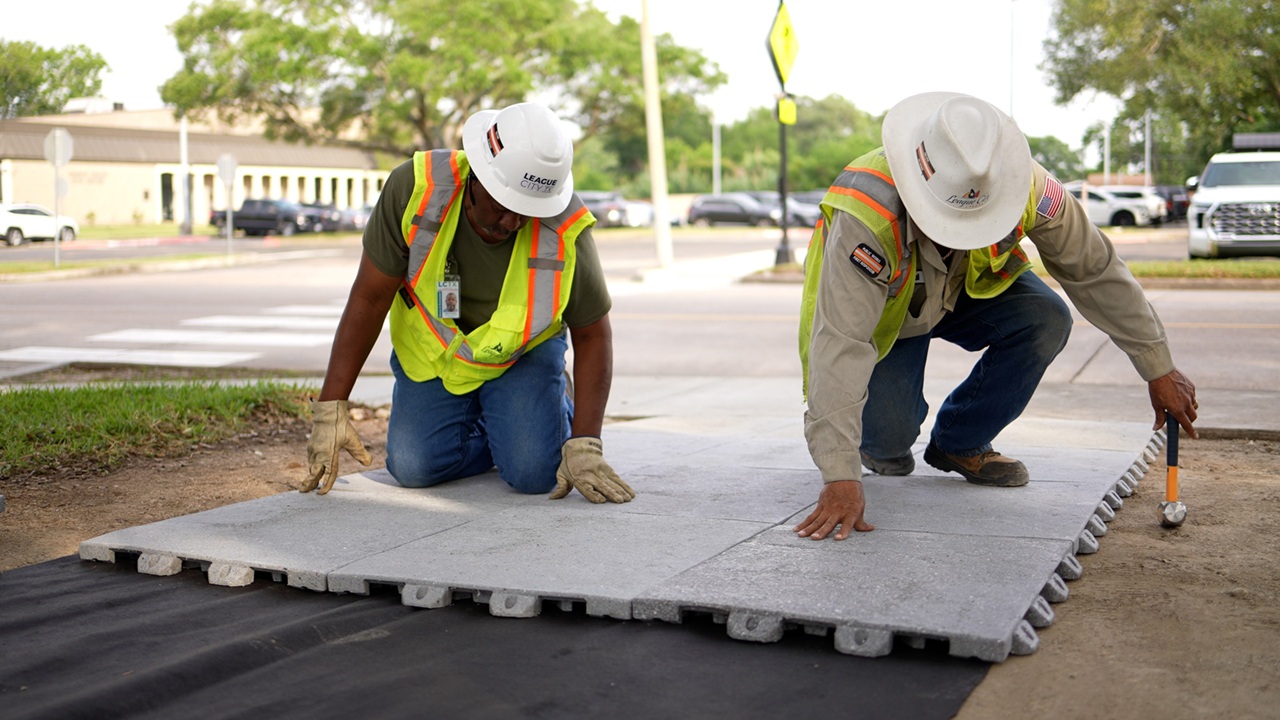
Carlene Neeley is a 78-year-old woman who suffers from peripheral neuropathy. Among other effects, the condition makes it difficult and sometimes dangerous for her to navigate uneven surfaces. She is also an executive assistant in the city manager’s office in League City, Texas, USA, and occasionally walks to work from a small parking lot down an unpaved, rocky path to the sidewalk across from city hall. The experience is often uncomfortable for her.
The path itself sits below several live oak trees—the same kind that adorn League City’s flag—and also runs across their root systems. The city’s arborist has been understandably protective of these symbolic giants and has prescribed a natural pathway, rather than a cement sidewalk, fearing the excavation needed to accommodate traditional cement would harm the trees’ root systems. Meanwhile, beyond Neeley’s use of the path, other employees and residents frequently use the parking lot for special events, elections, meetings, and a variety of other occasions. Many, like Neeley, deal with mobility challenges. So, what’s good for the trees isn’t entirely good for the people.
The live oak has become a de facto symbol for League City, a town adorned with lovely, canopied streets and picturesque tree-lined neighborhoods where just about anyone would want to live. Beyond their beauty, the trees provide shelter from the harsh Texas sun that beats upon this seaside community every summer. However, there’s a downside. The root systems of these beloved trees push the sidewalks skyward, creating tripping hazards that crews spend enormous amounts of time and resources trying to remedy.
Last year alone, the city repaired over 26,000 linear feet of sidewalks, many times because of tree roots. As assistant city manager, I oversee public works, and when it comes to sidewalks, it just seems like we’re on a treadmill and can’t catch up sometimes. As quickly as we repair one segment of sidewalk, another just pops up.
Homeowners, meanwhile, confront one of two onerous options—remove the tree or allow the city to reroute the sidewalk closer to their front door. Neither choice, understandably, has been warmly received. No one wants a sidewalk just outside their front door, and detracting from the ambience and beauty of a neighborhood isn’t really an option either. It’s a no-win scenario.
In 2024, we introduced a program for city staff called Elevate Academy. Elevate’s premise and intention focuses on empowering employees with tools and techniques that allow them to innovate and identify ways to “elevate” how local government functions and delivers services. After just one year, more than 230 employees completed some level of Elevate training. One of those was Patrick Self, a public works supervisor whose responsibilities include, among other things, pedestrian mobility. Acutely aware of the city’s tree-root dilemma, Self discovered an intriguing new product and decided to test it out as part of one of his Elevate assignments.
“It’s a sidewalk made of recycled materials,” said Self. “It looks and feels like sidewalk, except it doesn’t crack, shift, settle, or any of the things we’re dealing with now.”
Self said that among its best features, the sidewalk doesn’t require deep excavation, the usual forms required to hold liquid concrete in place as it dries, or even as much prep work to put into place. However, what interested him the most was that the product can be placed right over the roots of trees without compromising or injuring them, making both the city arborist and residents happy.
If that wasn’t enough benefit, Self said that Elevate Program calculations determined that the city could save $3,500 of taxpayer money for every tree they don’t have to remove. “We have so many of these tree issues,” said Self. “We could end up saving a lot of taxpayer dollars.”
Our team met with a homeowners association board to discuss piloting this product in their subdivision, and they were very excited to get this on the ground and potentially save their trees. Meanwhile, the city took care of what some are now calling “Carlene’s Pathway.”
A beautiful, new walkway now replaces the rocky road that once linked city hall’s annex parking lot to Walker Street. Following the prep work, Self’s crew assembled the 60-foot walkway in 45 minutes. Neeley and others with mobility challenges won’t have to worry anymore about the trek from the parking lot to city hall.
One morning, from the conference room on the second floor of city hall, I spied two residents out for a walk. They approached the new sidewalk and stopped. One bent down to feel the walkway. Both stood for a moment and appeared to discuss it before continuing down Carlene’s Pathway.
I like safe sidewalks, but what I like most is empowering our employees to develop solutions that lift our community and make life better for our residents. I love what happens when they truly believe and realize they can make a difference, and then actually go out and do it!
League City’s plans to address more tree/sidewalk issues and may even consider using this new type of walkway for trail development. You can meet both Carlene Neeley and Pat Self in a video that chronicles the installation of Carlene’s Pathway at youtu.be/7SXuSltlYmU.
The Elevate Academy has meanwhile empowered employees to develop more than 150 innovations in the last 14 months, resulting in more than $2 million in savings and efficiencies.

RICK DAVIS, ICMA-CM, is assistant city manager of League City, Texas, USA. He is the author of Elevating Trust in Local Government: The Power of Community-Based Strategic Planning. (rick.davis@leaguecitytx.gov)
New, Reduced Membership Dues
A new, reduced dues rate is available for CAOs/ACAOs, along with additional discounts for those in smaller communities, has been implemented. Learn more and be sure to join or renew today!
